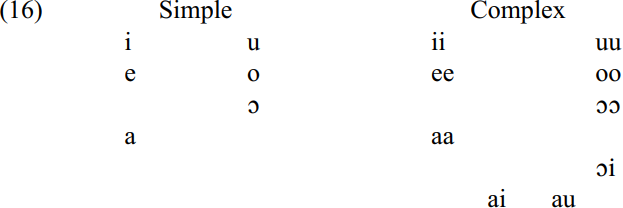


 Grammar
Grammar
 Tenses
Tenses
 Present
Present
 Past
Past
 Future
Future
 Parts Of Speech
Parts Of Speech
 Nouns
Nouns
 Verbs
Verbs
 Adverbs
Adverbs
 Adjectives
Adjectives
 Pronouns
Pronouns
 Pre Position
Pre Position
 Preposition by function
Preposition by function 
 Preposition by construction
Preposition by construction
 Conjunctions
Conjunctions
 Interjections
Interjections
 Grammar Rules
Grammar Rules
 Linguistics
Linguistics
 Semantics
Semantics
 Pragmatics
Pragmatics
 Reading Comprehension
Reading Comprehension|
Read More
Date: 2024-04-17
Date: 2024-05-14
Date: 2023-09-02
|
Below, we present our proposals for the vowel system of JamE.

We propose here that JamE has 15 vowels. These are made up of six simple vowels. The three features necessary to describe these involve

Redundantly, every vowel with the feature [back] also has the feature [labial].
There are nine complex vowels in JamE, six of these being double vowels. Each simple vowel has a complex counterpart in the form of a long or double version of itself, i.e. /ii/, /ee/, /aa/, /ɔɔ/ , /oo/ and /uu/. This introduces length or doubling as a feature which is characteristic of JamE complex nuclei. The remaining three complex vowels are diphthongs, rising from a low or lower-mid vowel to a high vowel. The first vowel element is always one of the two Low vowels, either /a/ or /ɔ/.
Wells (1973: 25) proposes that JamE has 16 vowels. His sixteenth vowel, /ɔɔ/, is treated by us as an allophone of /o/ when this vowel occurs before a tautosyllabic /r/.

The length feature implicit in our vowel inventory does not match the approach of Meade (2001: 42) to JamE vowels. He suggests that the main phonetic feature distinguishing between short vowels and long monophthongs was tenseness, with the short ones being lax and the long ones tense. This position, on the face of it, seems justified by the fact that, in JamE, much more so than in JamC, the non-low long vowels differ from their short equivalents not just in length but in height and tenseness. The long non-low vowels are always higher and tenser than their short equivalents. Whatever the merits of Meade’s approach for JamE, there is contradicting evidence. This involves the relationship between the third pair of vowels, /a/ and /aa/, in which no height or tense differences are involved. Length is the sole distinguishing feature here. Thus, if one is seeking to find a feature which distinguishes all short vowels in JamE from all long monophthongs, then tenseness versus laxness would not do the job but length would. It is on these grounds that we single out length as the primary distinction between these pairs, with relative height and tenseness being secondary, predictable features of the distinction in the case of the non-low vowels. This approach is much more economical than that of Meade (2001: 42) which proposes that tenseness is the primary feature for the non-low pairs of vowels, and length the primary one for the low pair.
|
|
|
|
دراسة تحدد أفضل 4 وجبات صحية.. وأخطرها
|
|
|
|
|
|
|
جامعة الكفيل تحتفي بذكرى ولادة الإمام محمد الجواد (عليه السلام)
|
|
|